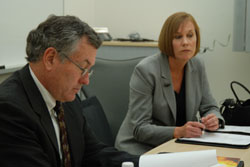California Assemblyman Visits Calit2 at UC San Diego
|
San Diego, CA, May 5, 2008 – California Assemblyman Martin Garrick visited Calit2 on the UC San Diego campus on May 2, where he saw several demonstrations of technologies developed by Calit2’s researchers.
Garrick, a Republican, is North County’s State Assemblyman for the 74th District, covering Oceanside, Carlsbad, Encinitas, Vista, San Marcos, Escondido, Solana Beach, Del Mar and Rancho Santa Fe. He held numerous positions in the administration of Ronald Reagan, including Deputy Senate House liaison. Garrick is currently a member of state committees on education, insurance and transportation. His visit to Calit2 included demonstrations of the Calit2 Wireless Traffic Report and a virtual reality tour of the Oakland Bay Bridge reconstruction, as well as a presentation by Jacobs School of Engineering professor Rajesh Gupta titled “The Educational Pipeline: From Classroom to Labs.”
Calit2 Associate Director Bill Hodgkiss began Garrick’s tour with a welcome and brief overview of the institute’s history and multidisciplinary approach. Gupta -- who holds the QUALCOMM Endowed Chair in Embedded Microsystems in the Computer Science and Engineering department -- began his talk by demonstrating a circuit board encoded with a program written by one of his students. Gupta told Garrick that his approach in the classroom “takes the mystery out of computing.”
“I’m not teaching my students ‘toys,’” he said. “What I’m teaching them is intuition. Other people give out books in their classrooms. I give out boxes.”
Gupta was referring to the box of basic computer parts that he includes in the course materials for his beginner programming classes. “You can read the material in a book, and you will get something out of it,” he said. “But if you do it hands-on, it stays with you always.”
Ganz Chockalingam, a principal development engineer with Calit2, demonstrated the institute’s Wireless Traffic Report, a toll-free, peer-to-peer wireless traffic information service that allows motorists to get real-time information on traffic speeds and delays on major San Diego highways. Chockalingam dialed into the system and explained how Garrick and his constituents can use their cell phones to create personalized traffic plans for their daily commute.
|
Next up was a stop at Calit2’s StarCAVE virtual-reality system, where Jacobs School of Engineering Dean Frieder Seible took Garrick and Joyce on a virtual tour of the Oakland Bay Bridge construction site. Wearing specially designed glasses, Garrick watched as Seible demonstrated a 3-D structural view of the bridge. Seible pointed out that the technology -- which in this case would allow construction teams to “see” what they’re building before they build it -- could one day become standard-issue on job sites around the world.
Garrick is the founder of Admiral Industries, Inc., a telecommunications company, and also owns and manages Admiral Property Company, a real estate investment firm. He told the Calit2 team that as a businessman, he “looks at things from a businessman’s point of view.” He said he could see the value in the StarCAVE technology because it would reduce change orders and other budget-busters since “you’re getting it right the first time.”
Joyce said the StarCAVE technology, which is navigated with a virtual “wand,” reminded her of the Tom Cruise science-fiction film, Minority Report.
In addition to touring the machine room of the San Diego Supercomputer Center, Garrick heard overviews from SDSC researchers on selected research and educational initiatives. Presenters included:
- Chaitan Baru, who gave an overview of a 9-1-1 emergency call analysis recently conducted in several California areas, which could assist CalTrans and other state agencies to enhance early warning systems for disasters such as earthquakes and fires; and
- Kimberly D. Mann Bruch, who presented HPWREN (High Performance Wireless Research and Education Network), a program using real-time video cameras in remote or hard-to-reach areas to facilitate learning for local Native American tribes, as well as to coordinate with local first responders to assist during emergency activities such as the recent San Diego wildfires.
Garrick’s visit to UCSD also included a quick stop at Calit2’s Community Cyberinfrastructure for Advanced Marine Microbial Ecology Research and Analysis (CAMERA), a one-on-one meeting with Dean Seible and a campus tour.
Related Links
Wireless Traffic Report
Jacobs School of Engineering
CAMERA
San Diego Supercomputer Center
Media Contacts
Tiffany Fox, (858) 246-0353, tfox@ucsd.edu


